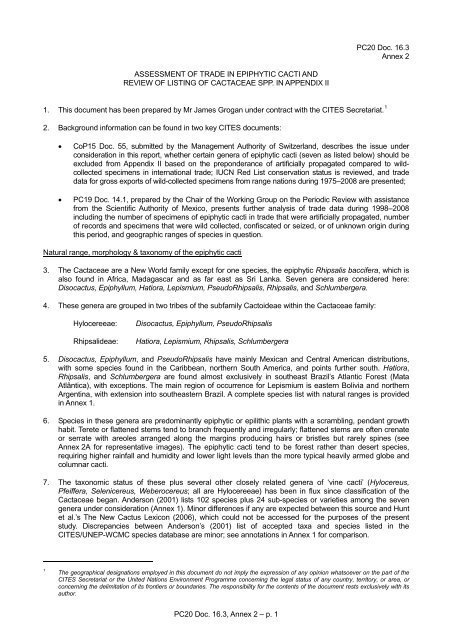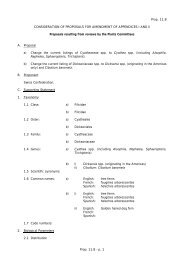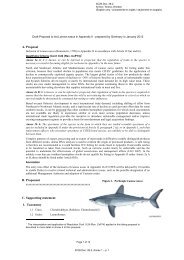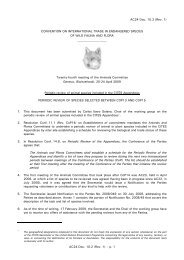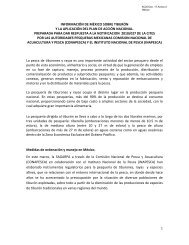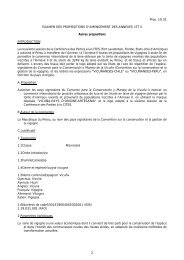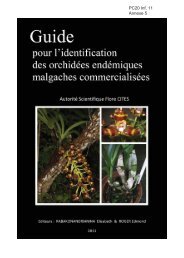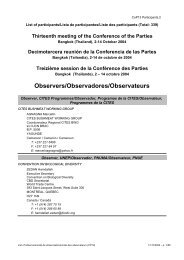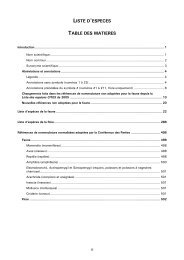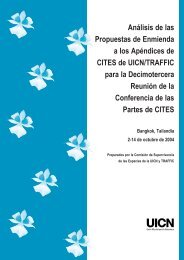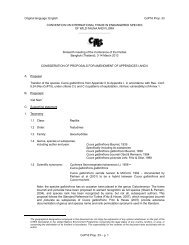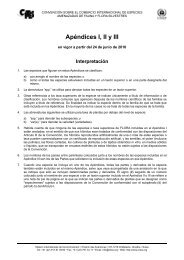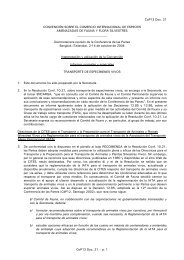PC20 Doc. 16.3 Annex 2 - Cites
PC20 Doc. 16.3 Annex 2 - Cites
PC20 Doc. 16.3 Annex 2 - Cites
Create successful ePaper yourself
Turn your PDF publications into a flip-book with our unique Google optimized e-Paper software.
ASSESSMENT OF TRADE IN EPIPHYTIC CACTI AND<br />
REVIEW OF LISTING OF CACTACEAE SPP. IN APPENDIX II<br />
<strong>PC20</strong> <strong>Doc</strong>. <strong>16.3</strong><br />
<strong>Annex</strong> 2<br />
1. This document has been prepared by Mr James Grogan under contract with the CITES Secretariat. 1<br />
2. Background information can be found in two key CITES documents:<br />
CoP15 <strong>Doc</strong>. 55, submitted by the Management Authority of Switzerland, describes the issue under<br />
consideration in this report, whether certain genera of epiphytic cacti (seven as listed below) should be<br />
excluded from Appendix II based on the preponderance of artificially propagated compared to wildcollected<br />
specimens in international trade; IUCN Red List conservation status is reviewed, and trade<br />
data for gross exports of wild-collected specimens from range nations during 1975–2008 are presented;<br />
PC19 <strong>Doc</strong>. 14.1, prepared by the Chair of the Working Group on the Periodic Review with assistance<br />
from the Scientific Authority of Mexico, presents further analysis of trade data during 1998–2008<br />
including the number of specimens of epiphytic cacti in trade that were artificially propagated, number<br />
of records and specimens that were wild collected, confiscated or seized, or of unknown origin during<br />
this period, and geographic ranges of species in question.<br />
Natural range, morphology & taxonomy of the epiphytic cacti<br />
3. The Cactaceae are a New World family except for one species, the epiphytic Rhipsalis baccifera, which is<br />
also found in Africa, Madagascar and as far east as Sri Lanka. Seven genera are considered here:<br />
Disocactus, Epiphyllum, Hatiora, Lepismium, PseudoRhipsalis, Rhipsalis, and Schlumbergera.<br />
4. These genera are grouped in two tribes of the subfamily Cactoideae within the Cactaceae family:<br />
Hylocereeae: Disocactus, Epiphyllum, PseudoRhipsalis<br />
Rhipsalideae: Hatiora, Lepismium, Rhipsalis, Schlumbergera<br />
5. Disocactus, Epiphyllum, and PseudoRhipsalis have mainly Mexican and Central American distributions,<br />
with some species found in the Caribbean, northern South America, and points further south. Hatiora,<br />
Rhipsalis, and Schlumbergera are found almost exclusively in southeast Brazil’s Atlantic Forest (Mata<br />
Atlântica), with exceptions. The main region of occurrence for Lepismium is eastern Bolivia and northern<br />
Argentina, with extension into southeastern Brazil. A complete species list with natural ranges is provided<br />
in <strong>Annex</strong> 1.<br />
6. Species in these genera are predominantly epiphytic or epilithic plants with a scrambling, pendant growth<br />
habit. Terete or flattened stems tend to branch frequently and irregularly; flattened stems are often crenate<br />
or serrate with areoles arranged along the margins producing hairs or bristles but rarely spines (see<br />
<strong>Annex</strong> 2A for representative images). The epiphytic cacti tend to be forest rather than desert species,<br />
requiring higher rainfall and humidity and lower light levels than the more typical heavily armed globe and<br />
columnar cacti.<br />
7. The taxonomic status of these plus several other closely related genera of ‘vine cacti’ (Hylocereus,<br />
Pfeiffera, Selenicereus, Weberocereus; all are Hylocereeae) has been in flux since classification of the<br />
Cactaceae began. Anderson (2001) lists 102 species plus 24 sub-species or varieties among the seven<br />
genera under consideration (<strong>Annex</strong> 1). Minor differences if any are expected between this source and Hunt<br />
et al.’s The New Cactus Lexicon (2006), which could not be accessed for the purposes of the present<br />
study. Discrepancies between Anderson’s (2001) list of accepted taxa and species listed in the<br />
CITES/UNEP-WCMC species database are minor; see annotations in <strong>Annex</strong> 1 for comparison.<br />
1 The geographical designations employed in this document do not imply the expression of any opinion whatsoever on the part of the<br />
CITES Secretariat or the United Nations Environment Programme concerning the legal status of any country, territory, or area, or<br />
concerning the delimitation of its frontiers or boundaries. The responsibility for the contents of the document rests exclusively with its<br />
author.<br />
<strong>PC20</strong> <strong>Doc</strong>. <strong>16.3</strong>, <strong>Annex</strong> 2 – p. 1
8. Recent phylogenetic studies have confirmed the tribe Rhipsalideae as a monophyletic group containing the<br />
four genera listed above plus Rhipsalidopsis, reconsituting a genus that had been merged with Hatiora<br />
(that is, H. gaertneri & H. rosea are proposed to reconstitute the genus Rhipsalidopsis). Researchers have<br />
also proposed major adjustments to Lepismium, including re-instatement of the genus Lymanbensonia (to<br />
include Lepismium incachacana plus two previously ‘unrelated’ Pfeiffera species) in a third tribe of<br />
epiphytic cacti, the Lymanbensonieae. As well, recent publications describe one new Rhipsalis species<br />
(R. aurea) and rediscovery of the long-lost Rhipsalis triangularis, both in Brazil’s Atlantic Forest. These<br />
findings suggest that current taxonomic understanding of the epiphytic cacti may yet see nomenclatural<br />
adjustments with implications for CITES listings (see references by Calvente et al., Korotkova et al. &<br />
Nyffeler).<br />
9. The high species diversity of the epiphytic cacti means that distinguishing species within and among<br />
genera based on vegetative or even fertile (flowering) material can be difficult for non-experts. As an<br />
example, all genera except Schlumbergera and Hatiora contain both flat-stemmed, non-spiny species and<br />
round-stemmed, spiny or bristly species. Also, several closely related genera of scrambling ‘vine cacti’ –<br />
noted above – that tend to root in the ground may superficially resemble epiphytic cacti, especially at the<br />
small (juvenile) sizes that are typically traded. In particular, several Selenicereus species bear striking<br />
vegetative and floral resemblance to members of Epiphyllum (for example, S. anthonyanus vs.<br />
E. anguliger). <strong>Annex</strong> 2B highlights similarities and differences among the epiphytic cacti considered in this<br />
report.<br />
Conservation status<br />
10. As of November 2011, no changes in IUCN Red List status for the seven genera considered here had<br />
been registered since March 2010 (see CoP15 <strong>Doc</strong>. 55, <strong>Annex</strong> 3). A total of 18 species are listed, with one<br />
Endangered (EN), four Near Threatened (NT), seven Least Concern (LC), and six Data Deficient (see<br />
<strong>Annex</strong> 1 this document). The major threat cited for EN, NT and LC species is habitat loss due to<br />
agriculture, logging, or ‘a variety of factors’. Wild-collected specimens in international trade were recorded<br />
or inferred for only three species on the IUCN Red List, all three of Least Concern. This trade represented<br />
28 specimens during the period 1975–2010 (20, 3 and 5 specimens of Epiphyllum phyllanthus, Lepismium<br />
cruciforme and L. warmingianum, respectively; see analysis below).<br />
11. While past IUCN categories of threat are not completely comparable to the current system, several<br />
previously listed epiphytic cacti species are omitted from the current Red List. For example, using 1994<br />
IUCN categories of threat, Taylor (1997) cited the conservation status of additional species from the<br />
Brazilian Atlantic Forest as follows:<br />
Extinct in the Wild (EW) Rhipsalis pentaptera<br />
Endangered (EN) Hatiora epiphylloides ssp. epiphylloides<br />
Vulnerable (VU) H. epiphylloides ssp. bradei, H. herminiae, R. baccifera ssp.<br />
hileabaiana, R. burchellii & R. mesembryanthemoides<br />
Low Risk (LR) H. salicornioides, Lepismium lumbricoides, R. baccifera ssp.<br />
baccifera, R. campos-portoana, R. cereuscula, R. clavata,<br />
R. grandiflora, R. neves-armondii, R. pachyptera,<br />
R. puniceodiscus, R. teres & R. trigona<br />
Data Deficient (DD) H. gaertneri, H. rosea, R. dissimilis, R. ewaldiana, R. juengeri,<br />
R. pulchra, Schlumbergera opuntioides & S. orssichiana<br />
12. It should also be noted that Calvente et al. (2005) considered several Brazilian epiphytic cacti as more<br />
threatened at local or regional levels than indicated by current or past IUCN Red List status, further<br />
highlighting inconsistencies and inadequacies in coverage of the epiphytic cacti by the IUCN Red List:<br />
Endangered (EN) R. mesembryanthemoides<br />
Vulnerable (VU) S. opuntioides & S. russelliana<br />
Near Threatened (NT) L. houlletianum, R. cereuscula, R. grandiflora,<br />
R. neves-armondii, R. paradoxa, R. pulchra & S. truncata<br />
<strong>PC20</strong> <strong>Doc</strong>. <strong>16.3</strong>, <strong>Annex</strong> 2 – p. 2
Trade analysis: Methods<br />
13. The analysis provided here summarizes UNEP-WCMC trade records for the seven genera under<br />
consideration during the period 1976–2010. Data for the year 2010 are incomplete but are sufficiently<br />
robust to indicate trends. The analysis is based on total reported trade, that is, it combines reported exports<br />
and imports for a given species over time. Where trade records do not match, for example, where X<br />
specimens are recorded exported by a given nation but no corresponding specimens are recorded<br />
imported by the destination nation, or vice versa, or where recorded export (or import) values exceed<br />
import (or export) values within records, the largest of the two values is considered to be the number of<br />
specimens in trade.<br />
14. 4236 trade records were provided. 58 records were eliminated because they clearly represented doublecounting,<br />
that is, separate records from exporting and importing nations documenting the same transaction<br />
during the same year. This left a total of 4178 trade records. Species-level trade was sub-divided by source<br />
code (A = artificially propagated, W = wild collected, I = confiscated or seized, U = unknown origin, blank =<br />
no source code provided). The reported country origin of specimens coded W, I, U and blank was<br />
compared to species’ natural ranges to determine whether these specimens could possibly have been wild<br />
collected; the definition of ‘range nation’ was applied generously, including all neotropical nations, in case<br />
range information was incomplete or erroneous. This means that W totals by species may or may not<br />
include W, I, U and blank specimens, depending on whether exported specimens originated from a<br />
potential range nation. No attempt was made to account for re-exports because this trade status could not<br />
be determined with certainty for any given report. Any doubt about a given record under these codes was<br />
treated conservatively, considering those specimens as wild collected.<br />
Trade analysis: Results<br />
15. Nearly 29.2 million specimens of epiphytic cacti in the seven genera under consideration were reported<br />
traded during 1976–2010 when export and import data are combined as described above. Considered<br />
separately, reported exports equalled 20.7 million specimens (70.9% of the combined total), while reported<br />
imports equalled 9.6 million specimens (33.2%). This means that nearly 30% of total specimens<br />
considered to be in trade were not recorded by exporters, while 67% of total specimens in trade were not<br />
recorded by importers.<br />
16. Exports of epiphytic cacti could be attributed to 64 nations during 1976-2010. Three exporting nations –<br />
Denmark, the Netherlands, and Canada – accounted for 91.4% of combined reported export trade over<br />
this period. The top ten exporting nations accounted for 99.1% of combined trade, with only one range<br />
nation for the epiphytic cacti, Guatemala (2.4%), contributing significantly to international trade (Table 1).<br />
Imports of epiphytic cacti could be attributed to 110 nations during this period. By far the most important<br />
importing nation was the USA, accounting for 58.4% of combined reported import trade. The top ten<br />
importing nations accounted for 90.9% of reported combined trade, with no range nations in the top ten<br />
(Table 1).<br />
TABLE 1. The top 10 exporting and importing nations of the epiphytic cacti during 1976-2010, with % of<br />
total. Based on combined reported trade for both exports and imports (see text explanation).<br />
EXPORTING % Total IMPORTING % Total<br />
Denmark 34.3 United States 58.4<br />
Netherlands 30.0 Switzerland 7.9<br />
Canada 27.1 Sweden 4.2<br />
Guatemala 2.4 Canada 3.9<br />
Poland 2.1 Germany 3.7<br />
Tanzania 1.6 Austria 3.4<br />
United States 0.6 Norway 2.6<br />
Australia 0.5 Denmark 2.4<br />
Germany 0.3 Finland 2.3<br />
Thailand 0.3 United Kingdom 2.2<br />
<strong>PC20</strong> <strong>Doc</strong>. <strong>16.3</strong>, <strong>Annex</strong> 2 – p. 3
17. Annual trade data (combined total for exports and imports) indicate that trade quantities of epiphytic cacti<br />
surged between 1986–1997, driven mainly by trade in artificially propagated specimens of<br />
Schlumbergera spp., Epiphyllum spp., and Hatiora spp. (Fig. 1). Trade dropped off sharply in 1998 and<br />
again in 2001.<br />
7000000<br />
6000000<br />
5000000<br />
4000000<br />
3000000<br />
2000000<br />
1000000<br />
0<br />
1976<br />
1977<br />
1978<br />
1979<br />
1980<br />
1981<br />
1982<br />
1983<br />
1984<br />
1985<br />
1986<br />
1987<br />
1988<br />
1989<br />
1990<br />
1991<br />
1992<br />
1993<br />
1994<br />
1995<br />
1996<br />
1997<br />
1998<br />
1999<br />
2000<br />
2001<br />
2002<br />
2003<br />
2004<br />
2005<br />
total specimens<br />
Schlumbergera spp.<br />
Epiphyllum spp.<br />
Hatiora spp.<br />
2006<br />
2007<br />
2008<br />
2009<br />
2010<br />
Figure 1. Annual levels of trade in epiphytic cacti, 1976–2010 (darkest line = total specimens), including the<br />
three species (or ‘spp.’) with the highest level of trade during this period.<br />
18. Examining annual trade data as above during 2001–2010, we see steady increase in trade quantities<br />
during the past decade (Fig. 2). The main driver of trade during the 1980s and 1990s, Schlumbergera spp.,<br />
essentially disappeared from international trade by 2007, while Epiphyllum spp. and Hatiora spp. also<br />
declined in importance compared to other species that came into significant trade after 2001. The most<br />
important of these were Rhipsalis baccifera, Rhipsalis spp., R. pilocarpa, Hatiora salicornioides, and<br />
R. ewaldiana. Except for Rhipsalis spp., none of these were traded in significant quantities before 2005.<br />
600000<br />
500000<br />
400000<br />
300000<br />
200000<br />
100000<br />
0<br />
total specimens<br />
Rhipsalis baccifera<br />
Schlumbergera spp.<br />
Rhipsalis spp.<br />
Rhipsalis pilocarpa<br />
Hatiora salicornioides<br />
Rhipsalis ewaldiana<br />
2001 2002 2003 2004 2005 2006 2007 2008 2009 2010<br />
Figure 2. Annual levels of trade of epiphytic cacti, 2001–2010 (darkest line = total specimens), including<br />
the six species (or ‘spp.’) with the highest level of trade during this period.<br />
<strong>PC20</strong> <strong>Doc</strong>. <strong>16.3</strong>, <strong>Annex</strong> 2 – p. 4
19. Trade data (exports and or imports) were recorded for 106 species, sub-species, ‘spp.’ and ‘hybrid’ in the<br />
seven genera under review during 1976–2010 as follows (see <strong>Annex</strong> 3 for complete data):<br />
No. specimens<br />
Disocactus 18 including ‘spp.’ & ‘hybrid’ 257,440<br />
Epiphyllum 16 including ‘spp.’ 5,661,505<br />
Hatiora 7 including ‘spp.’ & H. x graeseri 4,138,209<br />
Lepismium 14 including ‘spp.’ 40,462<br />
PseudoRhipsalis 4 including ‘spp.’ 56,329<br />
Rhipsalis 39 including ‘spp.’ & 7 sub-species 2,591,685<br />
Schlumbergera 8 including ‘spp.’ & S. x buckleyi 16,416,434<br />
TOTAL SPECIMENS 29,162,064<br />
20. Export and or import data coded W, I, U or blank were recorded for 48 species, sub-species and ‘spp.’<br />
during this period as follows:<br />
Disocactus<br />
No. specimens<br />
7 including ‘spp.’ 1,426<br />
Epiphyllum 6 including ‘spp.’ 2,972<br />
Hatiora 4 including ‘spp.’ 10,981<br />
Lepismium 6 including ‘spp.’ 114<br />
PseudoRhipsalis 2 19<br />
Rhipsalis 20 including ‘spp.’ & 3 sub-species 30,703<br />
Schlumbergera 3 including ‘spp.’ 336,732<br />
TOTAL SPECIMENS 382,947<br />
21. As described above, records coded W, I, U or blank were further analyzed by comparing reported nation of<br />
origin with species’ natural ranges. This eliminated 14 species (leaving 34 species, sub-species and ‘spp.’)<br />
from reported or possible trade in wild-collected species, as well as the large majority of W, I, U and blank<br />
coded specimens as follows (see <strong>Annex</strong> 4 for data with countries of origin for wild-collected specimens):<br />
Disocactus<br />
No. specimens<br />
7 including ‘spp.’ 107<br />
Epiphyllum 4 including ‘spp.’ 394<br />
Hatiora 2 including ‘spp.’ 3<br />
Lepismium 6 including ‘spp.’ 58<br />
PseudoRhipsalis 2 3<br />
Rhipsalis 10 including ‘spp.’ & 2 sub-species 458<br />
Schlumbergera 3 including ‘spp.’ 150<br />
TOTAL SPECIMENS 1,173<br />
22. To summarize, this analysis found that 1,173 wild-collected or possibly wild-collected specimens of 34<br />
species, sub-species or ‘spp.’ were traded internationally during the 35 years since 1976 (<strong>Annex</strong> 4). These<br />
numbers represented almost 0% to 73% of total reported specimens for a given species, and 0.004% of<br />
total specimens in trade during this period.<br />
<strong>PC20</strong> <strong>Doc</strong>. <strong>16.3</strong>, <strong>Annex</strong> 2 – p. 5
23. Other notable results from this analysis include:<br />
98.7% of all specimens in trade were coded A (Artificially propagated).<br />
87.7% of all specimens were traded as ‘spp.’, that is, of indeterminate specific origin.<br />
The rate of wild collection or possible wild collection for named species was higher than for ‘spp.’<br />
records, but the difference was not large considering the number of specimens in trade (0.0075% for<br />
named species vs. 0.0036% for ‘spp.’). That is, the large numbers of ‘spp.’ in trade do not appear to<br />
hide significant trade of wild-collected specimens of named species.<br />
Conclusions<br />
24. Available trade data indicate that quantities of wild-collected epiphytic cacti in international trade are<br />
negligible. This conclusion applies also to species traded in increasing quantities since 2005 (Fig. 2).<br />
25. The vast majority of trade, on both exporting and importing ends, involves artificially propagated specimens<br />
originating outside of range nations. The near disappearance in recent years of formerly prominent species<br />
in trade – Schlumbergera spp., Epiphyllum spp., and Hatiora spp., Figs. 1 & 2) – indicates that<br />
‘homegrown’ industries may now exist in former importing nations to supply domestic markets with<br />
extremely popular ornamental hanging cacti.<br />
26. The epiphytic cacti discussed here are highly diverse. This means that distinguishing species is difficult<br />
due to convergent growth forms within and among genera (<strong>Annex</strong> 2). While most species assume a<br />
pendant growth habit in the wild, this habit may not be obvious when specimens are packed for<br />
international shipment and inspection by customs agents, especially when specimens in trade are juvenile<br />
plants. As well, juvenile plants may exhibit bristly or spiny dimorphism (see <strong>Annex</strong> 2B, Rhipsalis paradoxa),<br />
further blurring distinctions between epiphytic and non-epiphytic cacti.<br />
27. A second identification issue concerns the four genera of ‘vine cacti’ not included in the present study<br />
(Hylocereus, Pfeiffera, Selenicereus, Weberocereus), as well as other essentially terrestrial cacti that may<br />
assume a pendent growth habit under both natural and artificial growing conditions (for example, some<br />
Cleistocactus species). That vine cacti are ground rooting rather than epiphytic in habit may not be obvious<br />
at the moment of transport across international borders. Also, juvenile plants may be indistinguishable<br />
between the two groups of plants. These additional genera thus present significant look-alike issues that<br />
should be assessed if a proposal for de-listing the epiphytic cacti from Appendix II moves forward.<br />
28. Molecular studies could introduce formal adjustments to taxonomic relationships among the epiphytic cacti<br />
in the near future. As noted, reconstitution of Rhipsalidopsis (Hatiora gaertneri + H. rosea) has recently<br />
been proposed, as well as re-instatement of the genus Lymanbensonia and the tribe Lymanbensonieae.<br />
Any proposal to de-list the epiphytic cacti from Appendix II will need to account for these proposed<br />
changes, ideally including a mechanism to account for future changes.<br />
Recommendations<br />
29. The Cactaceae are a New World group of up to 1800 species, representing a wide range of adaptations to<br />
arid or semi-arid environments, often with barely perceptible morphological differences among species. As<br />
reviewed in the next section, the family has been listed on CITES Appendix II since 1975 in response to<br />
intense harvest pressures on certain species and wild populations, and to the difficulty of distinguishing<br />
among highly similar species. Considering the small population size and highly restricted range of many<br />
Cactaceae, this family-level listing continues to play an essential conservation role through regulation of<br />
international trade.<br />
30. Many epiphytic cacti species face significant threats to survival, especially in Brazil’s Atlantic Forest where<br />
habitat loss continues. But no species considered in this report appears threatened by wild collection for<br />
international trade. Unlike many epiphytic orchids, for example, market demand for wild-collected epiphytic<br />
cacti appears to be low, perhaps because floral characters of most species are relatively nondescript<br />
compared to the highly diverse Orchidaceae.<br />
31. Trade analysis presented here indicates that the epiphytic cacti do not meet the criteria of Resolution<br />
Conf. 9.24 (Rev. CoP15) for inclusion of species in Appendix II, and should be considered for deletion.<br />
They are not frequently traded internationally except as artificially propagated specimens, and identification<br />
<strong>PC20</strong> <strong>Doc</strong>. <strong>16.3</strong>, <strong>Annex</strong> 2 – p. 6
issues appear surmountable given the relatively small number of species involved and morphological<br />
categories represented.<br />
32. If it is determined that the epiphytic cacti do not meet the criteria for inclusion on Appendix II, then<br />
Resolution Conf. 9.24 (Rev. CoP15), <strong>Annex</strong> 2b, which states that species may be included in Appendix II if<br />
“... specimens of the species in the form in which they are traded resemble specimens of a species<br />
included in Appendix II”, does not apply to this group.<br />
Review of the listing of Cactaceae spp. in Appendix II<br />
33. The Cactaceae are a primarily New World plant family adapted to arid environments, with exceptions as<br />
noted in this report. All American species of the Cactaceae were listed on Appendix II at the inception of<br />
CITES in 1975. The current annotation #4 reads:<br />
All parts and derivatives, except:<br />
a) seeds (including seedpods of Orchidaceae), spores and pollen (including pollinia). The exemption<br />
does not apply to seeds from Cactaceae spp. exported from Mexico, and to seeds from<br />
Beccariophoenix madagascariensis and Neodypsis decaryi exported from Madagascar;<br />
b) seedling or tissue cultures obtained in vitro, in solid or liquid media, transported in sterile<br />
containers;<br />
c) cut flowers of artificially propagated plants;<br />
d) fruits and parts and derivatives thereof of naturalized or artificially propagated plants of the genus<br />
Vanilla (Orchidaceae) and of the family Cactaceae;<br />
e) stems, flowers, and parts and derivatives thereof of naturalized or artificially propagated plants of<br />
the genera Opuntia subgenus Opuntia and Selenicereus (Cactaceae); and<br />
f) finished products of Euphorbia antisyphilitica packaged and ready for retail trade.<br />
34. Exclusions from Appendix II within the taxa adopted at CoP10 (1997, Harare) and remaining in effect until<br />
the present time are as follows:<br />
Artificially propagated specimens of the following hybrids and/or cultivars are not subject to the provisions<br />
of the Convention:<br />
Hatiora x graeseri;<br />
Schlumbergera x buckleyi;<br />
Schlumbergera russelliana x Schlumbergera truncata;<br />
Schlumbergera orssichiana x Schlumbergera truncata;<br />
Schlumbergera opuntioides x Schlumbergera truncata;<br />
Schlumbergera truncata (cultivars);<br />
Cactaceae spp. colour mutants grafted on the following grafting stocks: Harrisia "Jusbertii",<br />
Hylocereus trigonus or Hylocereus undatus;<br />
Opuntia microdasys (cultivars).<br />
35. These Hatiora and Schlumbergera species crosses and cultivars are widely marketed houseplants<br />
popularly known as Thanksgiving, Christmas and Easter cacti, named for the time of year they flower<br />
(November, December, and March-April, respectively). Cactaceae spp. colour mutants requiring grafting<br />
stocks are among the most popular houseplants in the world.<br />
<strong>PC20</strong> <strong>Doc</strong>. <strong>16.3</strong>, <strong>Annex</strong> 2 – p. 7
36. Three additional Cactaceae genera were excluded from Appendix II at CoP14 (2007 The Hague):<br />
Pereskia, Pereskiopsis and Quiabentia. These are easily identifiable leafy cacti artificially propagated and<br />
traded internationally in large numbers.<br />
37. Since CoP3 (1981 New Delhi), six Cactaceae genera (‘spp.’) and 41 species among an additional 13<br />
genera have been uplisted to Appendix I. These generally are genera or species with highly restricted or<br />
specialized habitat that additionally are under threat from collectors for horticultural purposes. Three<br />
species of Ariocarpus and six species of Turbinicarpus had already been listed on Appendix I when those<br />
genera were uplisted in 1992.<br />
38. Three species representing three genera have subsequently been restored to Appendix II, including an<br />
epiphytic cactus in one of the seven genera under consideration in this report: Disocactus macdougallii<br />
was uplisted to Appendix I at CoP4 (1983 Baborone) and restored to Appendix II at CoP11 (2000 Gigiri);<br />
Leuchtenbergia principis and Mammillaria plumosa were uplisted to Appendix I at CoP4 (1983 Gaborone)<br />
and restored to Appendix II at CoP9 (1994 Ft. Lauderdale).<br />
39. This leaves six Cactaceae genera plus an additional 29 species representing 11 genera currently listed in<br />
Appendix I as follows:<br />
Ariocarpus spp.<br />
Discocactus spp.<br />
Pelecyphora spp.<br />
Strombocactus spp.<br />
Turbinicarpus spp.<br />
Uebelmannia spp.<br />
Astrophytum asterias<br />
Aztekium ritteri<br />
Coryphantha werdermannii<br />
Echinocereus ferreirianus ssp. lindsayi<br />
Echinocereus schmollii<br />
Escobaria minima<br />
Escobaria sneedii<br />
Mammillaria pectinifera<br />
Mammillaria solisioides<br />
Melocactus conoideus<br />
Melocactus deinacanthus<br />
Melocactus glaucescens<br />
<strong>PC20</strong> <strong>Doc</strong>. <strong>16.3</strong>, <strong>Annex</strong> 2 – p. 8<br />
Melocactus paucispinus<br />
Obregonia denegrii<br />
Pachycereus militaris<br />
Pediocactus bradyi<br />
Pediocactus knowltonii<br />
Pediocactus paradinei<br />
Pediocactus peeblesianus<br />
Pediocactus sileri<br />
Sclerocactus brevihamatus ssp. tobuschii<br />
Sclerocactus erectocentrus<br />
Sclerocactus glaucus<br />
Sclerocactus mariposensis<br />
Sclerocactus mesaeverdae<br />
Sclerocactus nyensis<br />
Sclerocactus papyracanthus<br />
Sclerocactus pubispinus<br />
Sclerocactus wrightiae
References<br />
Anderson EF (2001) The Cactus Family. Timber Press, Portland, OR, USA. 776 pp.<br />
Calvente AM, Freitas MF & Andreata RHP (2005) Listagem, distribuição geográfica e conservação das<br />
espécies de Cactaceae no Estado do Rio de Janeiro. Rodriguésia 56: 141-162.<br />
Calvente A, Zappi DC, Forest F & Lohmann LG (2011) Molecular phylogeny of tribe Rhipsalideae (Cactaceae)<br />
and taxonomic implications for Schlumbergera and Hatiora. Molecular Phylogenetics and Evolution 58:<br />
456-468.<br />
Eggli U, Marchesi E, Bonifacino M & Nyffeler R (2008) Taxonomy and distribution of epiphytic cacti in Uruguay -<br />
Notes towards a checklist of Cactaceae of Uruguay, Part 3. Haseltonia 14: 161-169.<br />
Hunt DR, Taylor N & Charles G (2006) The New Cactus Lexicon, Vols. I & II: Descriptions and Illustrations of<br />
the Cactus Family. DH Books, Milborne Port, UK. 898 pp.<br />
Korotkova N, Zabel L, Quandt D & Barthlott W (2010) A phylogenetic analysis of Pfeiffera and the reinstatement<br />
of Lymanbensonia as an independently evolved lineage of epiphytic Cactaceae within a new tribe<br />
Lymanbensonieae. Willdenowia 40: 151-172.<br />
Korotkova N, Borsch T, Quandt D, Taylor NP, Müller KF & Barthlott W (2011) What does it take to resolve<br />
relationships and to identify species within molecular markers? An example from the epiphytic<br />
Rhipsalideae (Cactaceae). American Journal of Botany 98: 1549-1572.<br />
Nyffeler R (2002) Phylogenetic relationships in the cactus family (Cactaceae) based on evidence from<br />
trnK/matK and trnL-trnF sequences. American Journal of Botany 89: 312-326.<br />
Taylor NP (1997) Cactaceae. In: Oldfield S (comp.), Cactus and Succulent Plants –<br />
Status Survey and Conservation Action Plan, pp. 17-20, 199-202. Cactus and Succulent Specialist Group<br />
IUCN/SSC, Gland, Switzerland & Cambridge, UK.<br />
UNEP World Conservation Monitoring Centre. 2011. Checklist of CITES Species, Part 2: History of CITES<br />
Listings. http://www.cites.org/eng/resources/pub/checklist11/History_of_CITES_listings.pdf<br />
<strong>PC20</strong> <strong>Doc</strong>. <strong>16.3</strong>, <strong>Annex</strong> 2 – p. 9
ANNEX 1<br />
SPECIES LIST FOR EPIPHYTIC CACTI, WITH NATURAL RANGES<br />
Species without annotation are listed by Anderson (2001), appear in the CITES/UNEP-WCMC species list, and<br />
were traded internationally during 1976-2010. Annotation key: † not listed by Anderson (2001); § not included<br />
on CITES/UNEP-WCMC species list; no reported trade. IUCN Red List categories: EN endangered, VU<br />
vulnerable, NT near threatened, LC least concern, DD data deficient.<br />
SPECIES NATURAL RANGE + IUCN RED LIST STATUS +<br />
NOTES<br />
Disocactus ackermannii Mexico<br />
Disocactus ackermannii var. ackermanii § Mexico<br />
Disocactus ackermannii var. conzattianus § Mexico<br />
Disocactus amazonicus Brazil, Colombia, Costa Rica, Ecuador, Nicaragua,<br />
Panama, Peru, Venezuela<br />
Disocactus aurantiacus Guatemala, Honduras, Mexico, Nicaragua<br />
Disocactus biformis Guatemala, Honduras<br />
Disocactus cinnabarinus El Salvador, Guatemala, Honduras, Mexico<br />
Disocactus eichlamii Guatemala<br />
Disocactus flagelliformis Mexico<br />
Disocactus kimnachii Costa Rica<br />
Disocactus macdougallii Mexico<br />
Disocactus macranthus Mexico<br />
Disocactus martianus Mexico<br />
Disocactus nelsonii Guatemala, Honduras, Mexico<br />
Disocactus phyllanthoides Mexico<br />
Disocactus quezaltecus Guatemala<br />
Disocactus schrankii Mexico<br />
Disocactus speciosus Mexico<br />
Disocactus hybrid (x hybridus) † § Mexico; => D phyllanthoides x D speciosus<br />
Epiphyllum anguliger Mexico<br />
Epiphyllum cartagense Costa Rica, Panama<br />
Epiphyllum caudatum Mexico; may = E pumilum<br />
Epiphyllum columbiense Colombia, Costa Rica, Ecuador, Panama, Venezuela<br />
Epiphyllum costaricense Costa Rica, Panama<br />
Epiphyllum crenatum Belize, Guatemala, Honduras, Mexico, Panama<br />
Epiphyllum crenatum var. crenatum § Belize, Guatemala, Honduras, Mexico, Panama<br />
Epiphyllum crenatum var. kimnachii § Mexico<br />
Epiphyllum floribundum Peru<br />
Epiphyllum grandilobum Costa Rica, Panama<br />
Epiphyllum guatemalense Guatemala, Honduras, Mexico<br />
Epiphyllum hookeri Belize, Costa Rica, Cuba, El Salvador, Guatemala,<br />
Honduras, Mexico, Nicaragua, Panama, Trinidad and<br />
Tobago, Venezuela<br />
Epiphyllum laui Mexico<br />
Epiphyllum lepidocarpum Costa Rica<br />
Epiphyllum oxypetalum Costa Rica, El Salvador, Guatemala, Honduras, Mexico,<br />
Nicaragua<br />
<strong>PC20</strong> <strong>Doc</strong>. <strong>16.3</strong>, <strong>Annex</strong> 2 – p. 10
SPECIES NATURAL RANGE + IUCN RED LIST STATUS +<br />
NOTES<br />
Epiphyllum phyllanthus Argentina, Bolivia, Brazil, Colombia, Ecuador, French<br />
Guyana, Guyana, Panama, Paraguay, Peru, Suriname,<br />
Uruguay, Venezuela; LC<br />
Epiphyllum pittieri Costa Rica, Nicaragua, Panama<br />
Epiphyllum pumilum Belize, Guatemala, Mexico<br />
Epiphyllum rubrocoronatum Colombia, Ecuador, Panama<br />
Epiphyllum thomasianum Costa Rica, Guatemala, Honduras, Mexico, Nicaragua<br />
Epiphyllum trimetrale Colombia<br />
Hatiora epiphylloides Brazil<br />
Hatiora epiphylloides ssp. bradei Brazil<br />
Hatiora epiphylloides ssp. epiphylloides Brazil<br />
Hatiora gaertneri Brazil<br />
Hatiora graeseri † Brazil<br />
Hatiora herminiae Brazil<br />
Hatiora rosea Brazil<br />
Hatiora salicornioides Brazil<br />
Hatiora x graeseri † § Brazil; = H. gaertneri x H. rosea<br />
Lepismium aculeatum Argentina, Brazil, Paraguay; may be sub-population of<br />
L. lumbricoides<br />
Lepismium bolivianum Bolivia<br />
Lepismium brevispinum Peru, Ecuador<br />
Lepismium crenatum Bolivia, Peru<br />
Lepismium cruciforme Argentina, Brazil, Paraguay, Uruguay; LC<br />
Lepismium houlletianum Argentina, Brazil; LC<br />
Lepismium ianthothele Argentina, Bolivia<br />
Lepismium incachacanum Bolivia<br />
Lepismium lorentzianum Argentina, Bolivia<br />
Lepismium lumbricoides Argentina, Bolivia, Brazil, Paraguay, Uruguay<br />
Lepismium micranthum Peru<br />
Lepismium miyagawae Bolivia<br />
Lepismium monacanthum Argentina, Bolivia<br />
Lepismium paranganiense Bolivia<br />
Lepismium warmingianum Argentina, Brazil, Paraguay; LC<br />
PseudoRhipsalis acuminata Costa Rica, Panama<br />
PseudoRhipsalis alata Jamaica<br />
PseudoRhipsalis himantoclada Costa Rica, Panama<br />
PseudoRhipsalis horichii Costa Rica, Panama<br />
PseudoRhipsalis lankesteri Costa Rica<br />
PseudoRhipsalis ramulosa Belize, Bolivia, Brazil, Colombia, Costa Rica, Ecuador,<br />
El Salvador, Guatemala, Haiti, Honduras, Jamaica,<br />
Mexico, Nicaragua, Peru, Venezuela<br />
Rhipsalis baccifera Antigua and Barbuda, Argentina, Belize, Bolivia, Brazil,<br />
British Virgin Islands, Colombia, Costa Rica, Cuba,<br />
Dominican Republic, Ecuador, French Guyana, Guyana,<br />
Guatemala, Guyana, Haiti, Honduras, Jamaica,<br />
Madagascar, Martinique, Mexico, Netherlands Antilles<br />
<strong>PC20</strong> <strong>Doc</strong>. <strong>16.3</strong>, <strong>Annex</strong> 2 – p. 11
SPECIES NATURAL RANGE + IUCN RED LIST STATUS +<br />
NOTES<br />
Rhipsalis baccifera ssp. baccifera Belize, Brazil, Colombia, Costa Rica, Cuba, Dominican<br />
Republic, Ecuador, French Guiana, Guatemala,<br />
Guyana, Haiti, Honduras, Jamaica , Mexico ,<br />
Netherlands Antilles, Nicaragua, Panama, Peru, Puerto<br />
Rico, Suriname, Trinidad and Tobago, United States,<br />
Venezuela<br />
Rhipsalis baccifera ssp. erythrocarpa Kenya, Tanzania<br />
Rhipsalis baccifera ssp. hileiabaiana Brazil<br />
Rhipsalis baccifera ssp. horrida Madagascar<br />
Rhipsalis baccifera ssp. mauritiania Angola, Comoros, Ethiopia, Madagascar, Mauritius,<br />
Réunion, Seychelles, Sierra Leona, South Africa, Sri<br />
Lanka<br />
Rhipsalis baccifera ssp. shaferi Argentina, Bolivia, Brazil, Paraguay<br />
Rhipsalis burchellii Brazil<br />
Rhipsalis campos-portoana Brazil<br />
Rhipsalis cereoides Brazil; VU<br />
Rhipsalis cereuscula Argentina, Bolivia, Brazil, Paraguay, Uruguay<br />
Rhipsalis clavata Brazil<br />
Rhipsalis crispata Brazil; VU<br />
Rhipsalis cuneata Bolivia<br />
Rhipsalis dissimilis Brazil<br />
Rhipsalis elliptica Brazil; LC<br />
Rhipsalis ewaldiana Brazil<br />
Rhipsalis floccosa Argentina, Bolivia, Brazil, Paraguay, Peru, Uruguay,<br />
Venezuela; LC<br />
Rhipsalis floccosa ssp. floccosa Brazil<br />
Rhipsalis floccosa ssp. hohenauensis Argentina, Paraguay<br />
Rhipsalis floccosa ssp. oreophila Brazil<br />
Rhipsalis floccosa ssp. pittieri Venezuela<br />
Rhipsalis floccosa ssp. pulvinigera Brazil<br />
Rhipsalis floccosa ssp. tucumanensis Argentina, Bolivia, Peru<br />
Rhipsalis goebeliana Bolivia<br />
Rhipsalis grandiflora Brazil<br />
Rhipsalis hoelleri Brazil; DD<br />
Rhipsalis juengeri Brazil<br />
Rhipsalis lindbergiana Brazil<br />
Rhipsalis mesembryanthemoides Brazil<br />
Rhipsalis mesembryanthoides † Brazil<br />
Rhipsalis micrantha Colombia, Costa Rica, Ecuador, Guatemala, Peru,<br />
Venezuela<br />
Rhipsalis neves-armondii Brazil<br />
Rhipsalis oblonga Brazil; NT<br />
Rhipsalis occidentalis Ecuador, Peru, Suriname<br />
Rhipsalis olivifera Brazil<br />
Rhipsalis ormindoi Brazil<br />
Rhipsalis pacheco-leonis Brazil; DD<br />
Rhipsalis pacheco-leonis ssp. catenulata Brazil<br />
<strong>PC20</strong> <strong>Doc</strong>. <strong>16.3</strong>, <strong>Annex</strong> 2 – p. 12
SPECIES NATURAL RANGE + IUCN RED LIST STATUS +<br />
NOTES<br />
Rhipsalis pacheco-leonis ssp. pacheco-leonis Brazil<br />
Rhipsalis pachyptera Brazil, Guyana, Suriname<br />
Rhipsalis paradoxa Brazil; LC<br />
Rhipsalis paradoxa ssp. paradoxa Brazil<br />
Rhipsalis paradoxa ssp. septentrionalis Brazil<br />
Rhipsalis pentaptera Argentina, Bolivia, Brazil<br />
Rhipsalis pilocarpa Brazil; VU<br />
Rhipsalis pulchra Brazil<br />
Rhipsalis puniceodiscus Brazil<br />
Rhipsalis russellii Brazil; VU<br />
Rhipsalis sulcata Brazil; DD<br />
Rhipsalis teres Brazil<br />
Rhipsalis trigona Brazil<br />
Schlumbergera buckleyi † Brazil; S. x buckleyi = S. russelliana x S. truncata<br />
Schlumbergera exotica (x exotica) † Brazil; S. x exotica = S. opuntioides x S. truncata<br />
Schlumbergera kautskyi Brazil; EN<br />
Schlumbergera microsphaerica Brazil; DD<br />
Schlumbergera microsphaerica ssp. candida Brazil<br />
Schlumbergera microsphaerica ssp.<br />
microsphaerica §<br />
Brazil<br />
Schlumbergera opuntioides Brazil; NT<br />
Schlumbergera orssichiana Brazil<br />
Schlumbergera reginae (x reginae) † Brazil; S. x reginae = S. orssichiana x S. truncata<br />
Schlumbergera russelliana Brazil<br />
Schlumbergera truncata Brazil<br />
<strong>PC20</strong> <strong>Doc</strong>. <strong>16.3</strong>, <strong>Annex</strong> 2 – p. 13
Note similarities among genera.<br />
Images are scanned from Anderson (2001).<br />
ANNEX 2A<br />
IMAGES OF REPRESENTATIVE EPIPHYTIC CACTI<br />
Disocactus ackermannii Epiphyllum pittieri Hatiora salicornioides Lepismium cruciformis<br />
(with fruit)<br />
PseudoRhipsalis himantoclada Rhipsalis baccifera Schlumbergera orssichiana<br />
ssp. baccifera<br />
<strong>PC20</strong> <strong>Doc</strong>. <strong>16.3</strong>, <strong>Annex</strong> 2 – p. 14
ANNEX 2B<br />
MORE SIMILARITIES AMONG GENERA OF EPIPHYTIC CACTI<br />
Top row: rounded/tubular stems with conspicuous bristles or spine. Bottom row: flattened, segmented stems.<br />
Images are scanned from Anderson (2001).<br />
Disocactus martianus Lepismium ianthothele Rhipsalis paradoxa<br />
(showing dimorphic stems)<br />
Hatiora epiphylloides Rhipsalis elliptica Schlumbergera opuntioides ssp. epiphylloides<br />
(with fruit)<br />
<strong>PC20</strong> <strong>Doc</strong>. <strong>16.3</strong>, <strong>Annex</strong> 2 – p. 15
ANNEX 3<br />
UNEP-WCMC trade data for seven genera of epiphytic cacti, 1976-2010. ‘Total Specimens’ shows sum of<br />
reported Imports + Exports as explained in the text. Source codes: A = Artificially propagated, W = wildcollected,<br />
I = confiscated or seized, U = unknown, blank = no code reported. ‘No. of nations’ shows the number<br />
of Importing and Exporting nations reporting trade during this period. ‘Range Export’ indicates the number of<br />
range nations reporting trade.<br />
Total By source code: Reported: No. of nations: Range<br />
Species Specimens A W I U blank Imports Exports Import Export Export<br />
Disocactus ackermannii 71 71 6 71 12 5 0<br />
Disocactus amazonicus 250 250 160 247 21 4 2<br />
Disocactus aurianticus 50 41 5 4 29 23 8 4 1<br />
Disocactus biformis 38 38 6 38 9 2 0<br />
Disocactus cinnabarinsis 53 53 7 46 12 4 0<br />
Disocactus eichlamii 25 25 0 25 6 1 0<br />
Disocactus flagelliformis 13,321 13,316 4 1 9,235 4,117 31 15 1<br />
Disocactus hybrid 6 6 6 0 1 1 0<br />
Disocactus kimnachii 2 2 0 2 1 1 0<br />
Disocactus macdougallii 2 2 0 2 1 1 0<br />
Disocactus macranthus 5,572 5,572 5,012 565 16 6 0<br />
Disocactus martianus 304 297 4 2 1 28 278 13 7 1<br />
Disocactus nelsonii 74 69 3 2 5 69 11 5 1<br />
Disocactus phyllanthoides 83 81 2 10 74 13 5 1<br />
Disocactus quezaltecus 20 20 5 20 6 2 0<br />
Disocactus schrankii 23 22 1 1 22 12 2 1<br />
Disocactus speciosus 249 249 10 244 13 3 0<br />
Disocactus spp. 237,297 235,900 25 56 1,316 3,294 234,100 36 21 7<br />
DISOCACTUS TOTALS 257,440 256,014 39 61 2 1,324 17,814 239,943<br />
Epiphyllum anguliger 1,631 1,631 1,297 346 16 8 0<br />
Epiphyllum cartagense 76 76 24 69 10 5 1<br />
Epiphyllum caudatum 30 26 4 5 26 8 2 1<br />
Epiphyllum crenatum 5,462 5,461 1 797 4,667 19 8 0<br />
Epiphyllum floribundum 29 29 3 26 6 1 0<br />
Epiphyllum grandilobum 10 10 5 9 4 4 1<br />
Epiphyllum guatemalense 31 31 2 29 10 2 0<br />
Epiphyllum hookeri 1,085 1,082 2 1 13 1,079 19 7 2<br />
Epiphyllum laui 23 23 10 23 4 1 0<br />
Epiphyllum lepidocarpum 19 19 16 19 3 3 1<br />
Epiphyllum oxypetalum 796 773 21 2 93 709 18 13 1<br />
Epiphyllum phyllanthus 10,118 10,098 19 1 10,054 9,571 13 12 7<br />
Epiphyllum pittieri 14 14 13 11 3 3 1<br />
Epiphyllum pumilum 27 27 6 27 11 2 0<br />
Epiphyllum thomasianum 107 107 25 106 13 3 2<br />
Epiphyllum spp. 5,642,047 5,639,126 47 189 31 2,654 4,493,353 1,165,864 57 42 19<br />
EPIPHYLLUM TOTALS 5,661,505 5,658,533 93 193 31 2,655 4,505,716 1,182,581<br />
<strong>PC20</strong> <strong>Doc</strong>. <strong>16.3</strong>, <strong>Annex</strong> 2 – p. 16
Total By source code: Reported: No. of nations: Range<br />
Species Specimens A W I U blank Imports Exports Import Export Export<br />
Hatiora epiphylloides 1 1 0 1 1 1 0<br />
Hatiora gaertneri 972,089 971,998 12 79 29,001 943,103 28 9 0<br />
Hatiora herminiae 20 20 0 20 1 1 1<br />
Hatiora rosea 1,283 1,234 1 48 1,010 276 14 7 0<br />
Hatiora salicornioides 476,981 476,976 2 2 1 165,455 326,886 28 10 1<br />
Hatiora x graeseri 1,288 1,288 1,288 0 1 1 0<br />
Hatiora spp. 2,686,547 2,675,711 479 100 10,257 126,359 2,571,830 45 14 1<br />
HATIORA TOTALS 4,138,209 4,127,228 3 541 100 10,337 323,113 3,842,116<br />
Lepismium aculeatum 25 18 3 4 20 9 4 5 2<br />
Lepismium bolivianum 26,833 26,833 21,772 25,724 13 5 0<br />
Lepismium crenatum 1 1 0 1 1 1 0<br />
Lepismium cruciforme 1,220 1,215 2 2 1 880 348 12 9 3<br />
Lepismium houlletianum 357 357 305 53 12 4 0<br />
Lepismium ianthothele 47 43 4 10 37 13 3 2<br />
Lepismium lorentzianum 17 17 0 17 5 1 0<br />
Lepismium lumbricoides 3,971 3,890 5 76 1,684 2,290 13 7 1<br />
Lepismium micranthum 24 24 1 24 6 2 0<br />
Lepismium miyagawae 38 38 3 35 6 1 0<br />
Lepismium monacanthum 116 116 103 14 8 4 1<br />
Lepismium paranganiense 41 41 3 38 10 3 0<br />
Lepismium warmingianum 4,507 4,502 5 4,492 15 5 5 1<br />
Lepismium spp. 3,265 3,253 8 4 3,192 96 10 8 2<br />
LEPISMIUM TOTALS 40,462 40,348 23 6 0 85 32,465 28,701<br />
Pseudorhipsalis alata 2 2 0 2 1 1 0<br />
Pseudorhipsalis himantoclada 4 3 1 1 3 2 2 1<br />
Pseudorhipsalis ramulosa 185 167 15 3 108 93 15 7 2<br />
Pseudorhipsalis spp. 56,138 56,138 0 56,138 1 1 0<br />
PSEUDORHIPSALIS TOTALS 56,329 56,310 15 1 0 3 109 56,236<br />
Schlumbergera kautskyi 630 630 0 630 1 1 0<br />
Schlumbergera microsphaerica 33 33 23 33 4 2 0<br />
Schlumbergera opuntioides 257 257 204 254 13 3 0<br />
Schlumbergera orssichiana 229 229 139 91 5 3 0<br />
Schlumbergera russelliana 3,746 3,744 2 3,634 112 10 6 1<br />
Schlumbergera truncata 448,680 437,255 1 1 11,423 56,887 392,920 26 19 2<br />
Schlumbergera<br />
x buckleyi 709 709 2 709 2 2 0<br />
Schlumbergera spp. 15,962,150 15,636,844 8 706 100,196 224,395 3,042,445 13,844,405 66 24 7<br />
SCHLUMBERGERA TOTALS 16,416,434 16,079,701 8 709 100,197 235,818 3,103,334 14,239,154<br />
<strong>PC20</strong> <strong>Doc</strong>. <strong>16.3</strong>, <strong>Annex</strong> 2 – p. 17
ANNEX 4<br />
Estimated numbers of wild-collected specimens of epiphytic cacti traded internationally during 1976-2010 by<br />
species or ‘spp.’ with origin of wild-collected (W) specimens. ‘Total no. of Specimens’ shows sum of reported<br />
Imports + Exports as explained in the text. Source codes: A = Artificially propagated, W = wild-collected, I =<br />
confiscated or seized, U = unknown, blank = no code reported. W, I, U or blank records were omitted from<br />
estimated number of wild-collected (W) specimens if country of origin did not match natural range (see text for<br />
explanation).<br />
Est. no. of Total no. of By source code:<br />
Species W specimens Specimens A W I U Blank Origin of W collected specimens*<br />
Disocactus aurianticus 4 50 41 5 4 Honduras 1990<br />
Disocactus flagelliformis 4 13,321 13,316 4 1 Mexico 1993<br />
Disocactus martianus 4 304 297 4 2 1 Mexico 1992-1993<br />
Disocactus nelsonii 3 74 69 3 2 Mexico 1996<br />
Disocactus phyllanthoides 2 83 81 2 Mexico 2004<br />
Disocactus schrankii 1 23 22 1 Mexico 1993<br />
Disocactus spp. 89 237,297 235,900 25 56 1,316 various 1979-2006<br />
Epiphyllum caudatum 4 30 26 4 Mexico 1992<br />
Epiphyllum hookeri 2 1,085 1,082 2 1 Belize 1999<br />
Epiphyllum phyllanthus 20 10,118 10,098 19 1 various 1992-2001<br />
Epiphyllum spp. 368 5,642,047 5,639,126 47 189 31 2,654 various 1987-2007<br />
Hatiora salicornioides 2 476,981 476,976 2 2 1 Brazil 1991<br />
Hatiora spp. 1 2,686,547 2,675,711 479 100 10,257 Brazil 1998<br />
Lepismium aculeatum 7 25 18 3 4 Argentina 1985, Uruguay 2005<br />
Lepismium cruciforme 3 1,220 1,215 2 2 1 Paraguay 1993, Brazil 2008<br />
Lepismium ianthothele 4 47 43 4 Argentina 1986<br />
Lepismium lumbricoides 27 3,971 3,890 5 76 Argentina 1986, 1997<br />
Lepismium warmingianum 5 4,507 4,502 5 Argentina 1997<br />
Lepismium spp. 12 3,265 3,253 8 4 Bolivia 1999/2006, Ecuador 2001<br />
Pseudorhipsalis himantoclada 1 4 3 1 Costa Rica 2008<br />
Pseudorhipsalis ramulosa 2 185 167 15 3 Dominican Republic 1995<br />
Rhipsalis baccifera 56 613,802 613,739 36 27 various 1981-2007<br />
Rhipsalis baccifera ssp. horrida 8 1,374 1,366 8 Madagascar 1991-2005<br />
Rhipsalis cereuscula 4 101,234 101,230 2 2 Mexico 1990, Paraguay 1993, Brazil 2008<br />
Rhipsalis clavata 1 2,191 2,189 1 1 unknown (code = I) 2002<br />
Rhipsalis floccosa ssp. tucumanensis 63 86 23 7 56 Argentina 1986, 1996<br />
Rhipsalis grandiflora 1 215 214 1 Brazil 2008<br />
Rhipsalis micrantha 4 2,174 2,169 4 1 Ecuador 2001<br />
Rhipsalis occidentalis 1 17 16 1 Ecuador 2001<br />
Rhipsalis puniceodiscus 5 60 55 5 Suriname 1994<br />
Rhipsalis spp. 315 1,360,237 1,330,360 76 64 1 29,736 various 1988-2008<br />
Schlumbergera russelliana 2 3,746 3,744 2 Mexico 2004<br />
Schlumbergera truncata 1 448,680 437,255 1 1 11,423 Mexico 2003<br />
Schlumbergera spp. 147 15,962,150 15,636,844 8 706 100,196 224,395 various 1979-2007<br />
TOTAL 1,173<br />
<strong>PC20</strong> <strong>Doc</strong>. <strong>16.3</strong>, <strong>Annex</strong> 2 – p. 18


